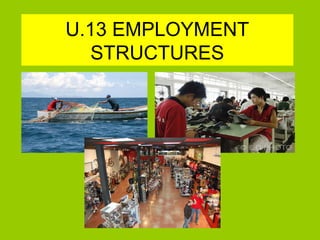
Employment structures
- 2. 1. ECONOMIC ACTIVITIES • People need food, clothes, a place to live, medical attention and so on. Economic activities are all the processes used to obtain the goods and services that people need. • Besides, economic activities provide jobs to the society. Thus, people have a salary to satisfy their needs
- 3. 2. ECONOMIC SECTORS Economic activities can be divided into three large sectors: primary, secondary and tertiary. Sometimes, we also can add a fourth sector which is called the quaternary sector.
- 4. PRIMARY SECTOR OR PRIMARY ACTIVITIES The primary sector consists of activities which obtain food and raw material from the land or the sea Examples: Farmers, miners, quarrymen, oilrig workers, fishermen...
- 5. SECONDARY SECTOR OR SECONDARY ACTIVITIES The secondary sector consists of economic activities which transform raw materials into finalished products. That means that secondary activities make or manufacturate things Examples of secondary activities: Steelmaking, car assembly, construction of buildings and roads, factories, food industry...
- 6. TERTIARY SECTOR OR TERTIARY ACTIVITIES It is also called the service sector. It consists of economic activities which provide a service to the society, but do not produce manufacturated goods Examples of tertiary activities: Teachers, politicians, football players, doctors, police officers, shop assistants, businessmen...
- 7. QUATERNARY SECTOR OR QUATERNARY ACTIVITIES These activities are a type of high-tech service industry that carries out research and provides information and advice Examples of quaternary activities: Scientists, engineers and researchers
- 8. 3. EMPLOYMENT STRUCTURES • They are diagrams that show us the percentage of each sector in a society. We usually only show the primary, the secondary and the tertiary sector • The percentage of each sector changes from one country to another country depending on its level of development
- 9. • Developed countries have more people who work in the tertiary sector • Developing countries have more people who work in the primary sector
- 10. In order to know the proportion of people working in each sector, we use employment structures. They are circular diagrams that show the percentage of each economic sector These diagrams usually show the three first sectors Even though, the employment structure of a country can change through the years depending on its level of development
- 11. 4. CHANGE OVER THE TIME IN THE BRITISH EMPLOYMENT STRUCTURE • Up to about 1800: Most of the people lived in the countryside so the primary activities had a 75% of the British employment structure. Besides, industrialisation was not developed at all so the percentage of the secondary activities was very low. Secondary activities reached a 15% and tertiary activities a 10%
- 12. • Since the beginning of the Industrial Revolution, many peasants moved to the cities to work in factories. As a result, the percentage of the secondary activities increased up to 55%. Using new machines in farming, peasants were not too required. Thus, the primary sector decreased and showed a 15%. Besides, there were more public services so the tertiary sector reached a 30%
- 13. • During the 20th century, people could afford to buy more services and manufacturated products, so the tertiary sector increased up to 70% • What is more, from the sixties many factories were located in developing countries and the secondary sector decreased until a 28% • The new technologies in the countryside have reduced the percentage of people who work in farms. As a result, the primary sector has a 2% in the British employment structure nowadays
- 14. 5. CHANGES BETWEEN THE EMPLOYMENT STRUCTURES OF THE UK • Even if there is an employment structure of the whole UK, we can notice some differences between the regions and countries of the United Kingdom • The South-East (London) is the place in the UK where the tertiary sector is bigger • The South-East has got the largest workforce of the country with 8 million of workers
- 15. • The North-West (Liverpool and Manchester) has the smallest percentage in the primary sector • On the contrary, Yorkshire (Leeds), East Midlands (Nottingham), the North (Newcastle) and Wales (Cardiff) have the biggest percentage in the primary sector in the UK. However, all these places have also a bigger percentage in the tertiary sector like the rest of the UK • The places with the smallest workforce in the UK are Northern Ireland (Belfast), East Anglia (Norwich) and Wales (Cardiff). They do not reach the million of workers • Even though, most regions in the UK have a similar employment structure
- 16. 6. VARIATIONS OF THE EMPLOYMENT STRUCTURES IN DIFFERENT COUNTRIES Different countries have different employment structures. The employment structure of a given country can tell you quite a lot about its economy. In the richest countries, for example, there will usually be more people working in the tertiary/quaternary sector than in the primary and secondary sectors. In the poorest countries, there tend to be more people working in the primary sector than in either the secondary or tertiary sectors.
- 17. In the richest country (USA), most people work in the tertiary sector. In the poorest country (Nepal), most people work in the primary sector. In Brazil, the labour force is more evenly distributed between the three sectors. Brazil is a country which is trying to reach a high development in the last decades, but it is still a developing country. Note that the quaternary sector has been included in the tertiary sector.